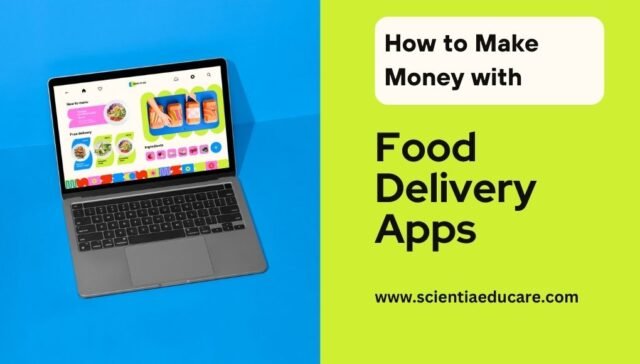The rise of food delivery apps has transformed the gig economy, offering numerous opportunities for individuals to earn income. Whether you’re seeking a full-time role or a side hustle, understanding how to maximize earnings through these platforms is essential. This article delves into various strategies, job prospects worldwide, and educational pathways to help you succeed in the food delivery sector.
Best food delivery side hustle,
Make extra cash delivering food,
Earn money with Uber Eats,
Food delivery income tips,
High-paying food delivery jobs
Understanding the Food Delivery Landscape
Food delivery apps like Uber Eats, DoorDash, Grubhub, and others have become integral to modern dining experiences. They connect customers with a wide range of restaurants, offering convenience at the tap of a button. For drivers and couriers, these platforms provide flexible earning opportunities.
Maximizing Earnings: Strategies for Success
To make the most out of food delivery gigs, consider the following strategies:
1. Sign Up with Multiple Platforms
Diversify your income sources by registering with several delivery services. This approach increases the likelihood of receiving consistent delivery requests. For instance, combining Uber Eats, DoorDash, and Grubhub can keep you busier than relying on a single platform.
2. Optimize Your Schedule
Identify peak hours, such as lunch and dinner times, to maximize delivery opportunities. Weekends and special events can also lead to higher demand. Aligning your availability with these peak periods can boost your earnings.
3. Focus on High-Demand Areas
Operate in densely populated urban areas or near clusters of popular restaurants. These zones often generate more frequent and lucrative delivery requests.
4. Maintain High Ratings
Providing excellent customer service, timely deliveries, and maintaining professionalism can lead to higher ratings. Many platforms offer incentives or prioritize high-rated drivers, enhancing your earning potential.
5. Manage Expenses Efficiently
Keep track of expenses such as fuel, vehicle maintenance, and tolls. Utilizing fuel-efficient routes and regular vehicle upkeep can help maximize your net earnings.
Job Prospects in the Food Delivery Industry
The food delivery sector offers various roles beyond driving, each contributing to the ecosystem’s efficiency.
1. Delivery Driver/Courier
Role: Transport food orders from restaurants to customers.
Requirements: Valid driver’s license, reliable vehicle or bicycle, and a smartphone.
Opportunities: Available worldwide through platforms like Uber Eats, DoorDash, Deliveroo, and others.
2. Warehouse Associate
Role: Manage inventory, package orders, and coordinate with delivery personnel.
Requirements: Organizational skills and the ability to handle physical tasks.
Opportunities: Companies like Amazon Fresh and Instacart offer such positions.
3. Logistics Coordinator
Role: Oversee delivery operations, optimize routes, and ensure timely deliveries.
Requirements: Experience in logistics, strong analytical skills, and proficiency in relevant software.
Opportunities: Larger delivery companies and startups often seek logistics coordinators.
4. Customer Support Representative
Role: Assist customers with order issues, handle complaints, and provide information.
Requirements: Strong communication skills and problem-solving abilities.
Opportunities: Most delivery platforms have customer support teams, with roles available globally.
Educational Pathways: Top Institutions Offering Relevant Courses
Pursuing formal education in logistics and supply chain management can open doors to advanced roles within the food delivery industry. Here are some top institutions offering relevant programs:
1. Michigan State University
Program: Bachelor’s in Supply Chain Management
Website: https://broad.msu.edu/undergraduate/programs/supply-chain-management/
2. Arizona State University
Program: Bachelor of Science in Supply Chain Management
Website: https://wpcarey.asu.edu/undergraduate-degrees/supply-chain-management
3. Massachusetts Institute of Technology (MIT)
Program: Master’s in Supply Chain Management
Website: https://mitsloan.mit.edu/masters-programs/master-of-applied-science-in-supply-chain-management
4. Hong Kong Polytechnic University
Program: Bachelor of Business Administration (Hons) in Global Supply Chain Management
Website: https://www.polyu.edu.hk/fb/ug/gsclm/
5. Cranfield University
Program: MSc in Logistics and Supply Chain Management
Website: https://www.cranfield.ac.uk/som/masters-courses/logistics-and-supply-chain-management
Further Reading and Resources
To deepen your understanding of the food delivery industry and strategies to maximize earnings, consider exploring the following resources:
- “How Online Food Delivery Apps Make Money”
https://www.mobileappdaily.com/knowledge-hub/how-online-food-delivery-make-money - “Which Delivery App Pays the Most?”
https://roadwarrior.app/blog/which-delivery-app-pays-the-most/ - “26 of the Best Colleges for Supply Chain Management To Consider”
https://www.indeed.com/career-advice/career-development/best-college-for-supply-chain-management
Future Trends in the Food Delivery Industry
The food delivery sector continues to evolve with advancements in technology and changing consumer preferences. Here are some future trends that could shape the industry:
1. Rise of Autonomous Delivery
Self-driving vehicles and drones are being tested by companies like Uber Eats, Domino’s, and Amazon to enhance delivery efficiency. This shift could reduce labor costs and increase profitability for businesses.
2. Expansion of Dark Kitchens
Also known as ghost kitchens, these establishments operate exclusively for food delivery services, reducing operational costs and allowing restaurants to scale efficiently.
3. AI and Data Analytics Optimization
Artificial Intelligence (AI) and big data analytics are helping food delivery platforms optimize routes, predict demand, and improve customer experience.
4. Sustainable and Eco-Friendly Initiatives
Consumers are increasingly demanding environmentally friendly packaging and carbon-neutral delivery options. Companies are focusing on sustainability by promoting electric bikes and reducing plastic usage.
Conclusion
Food delivery apps offer a flexible and lucrative way to earn money, whether as a part-time gig or a full-time career. By leveraging multiple platforms, optimizing work hours, and exploring career advancements in logistics and customer service, individuals can maximize their earnings. Moreover, those looking to grow professionally in the field can pursue higher education in supply chain management, logistics, or business administration to unlock better opportunities.
With rapid technological advancements and evolving consumer preferences, the future of food delivery holds immense potential. Staying updated with industry trends and improving efficiency will help individuals thrive in this ever-growing market.















Can you be more specific about the content of your article? After reading it, I still have some doubts. Hope you can help me.